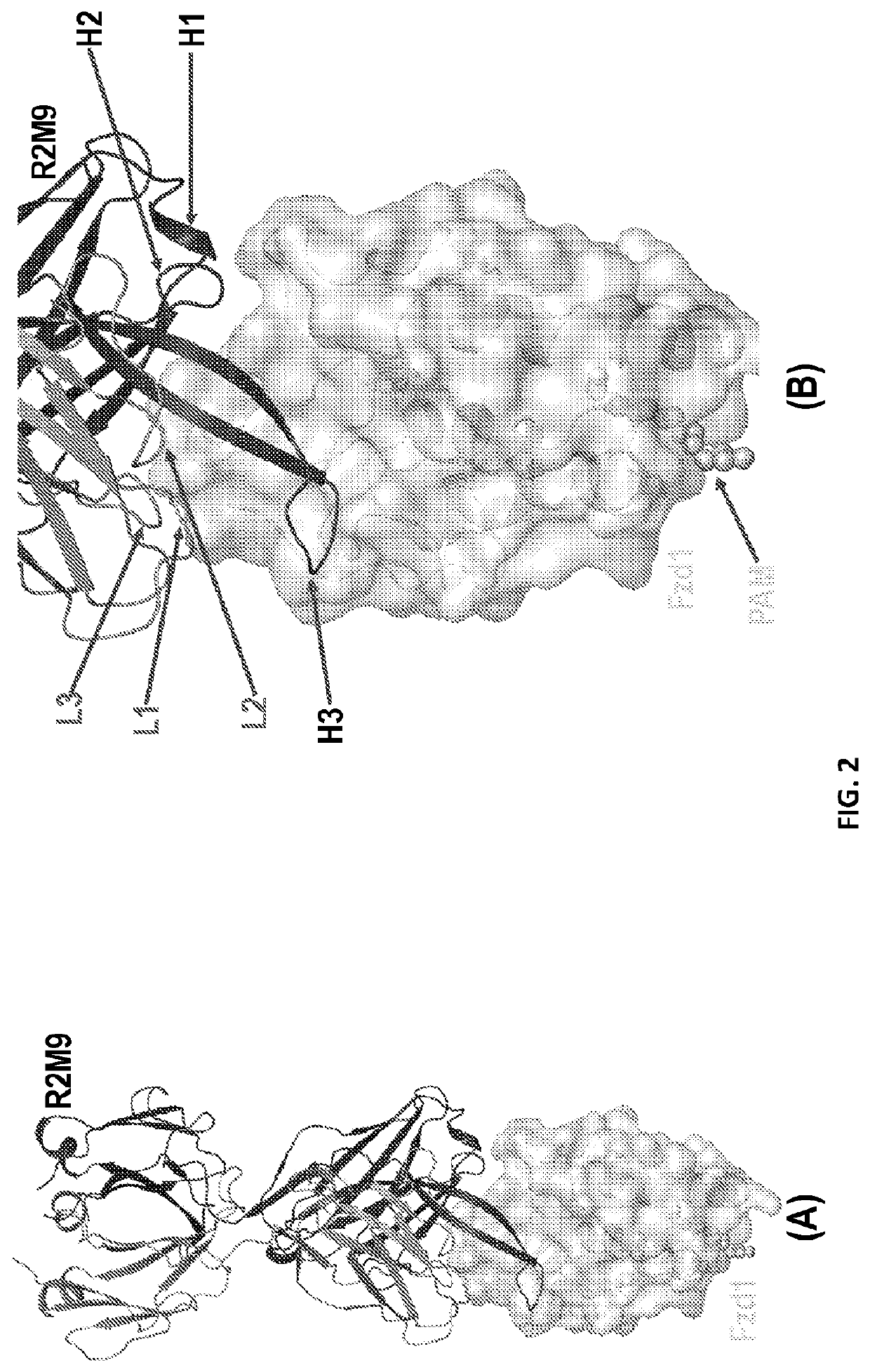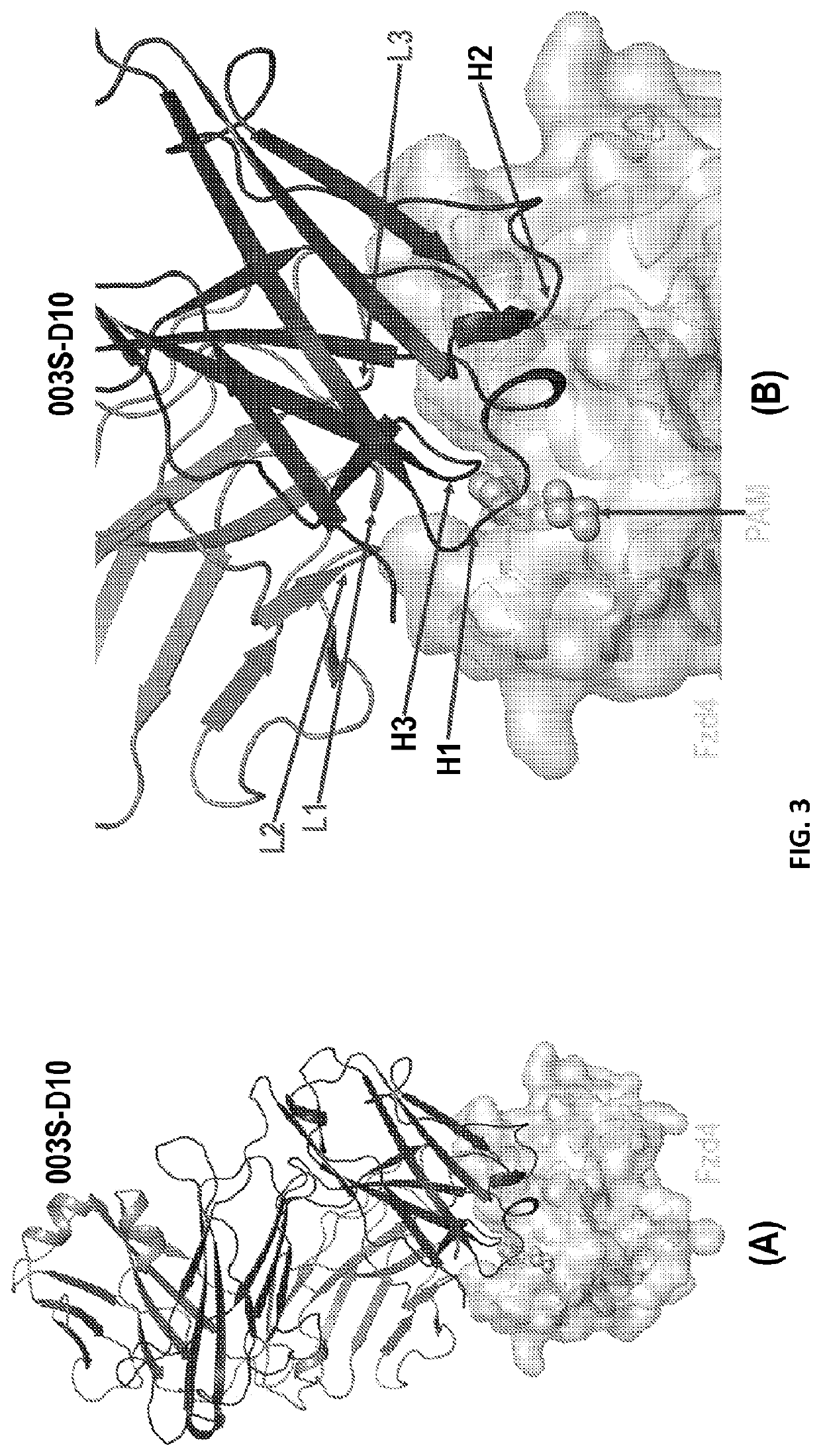Anti-frizzled antibodies and methods of use
a technology which is applied in the field of anti-frizzled antibodies and antigen binding fragments, to achieve the effects of increasing bone cortical thickness, increasing bone mineral density, and increasing bone volum
- Summary
- Abstract
- Description
- Claims
- Application Information
AI Technical Summary
Benefits of technology
Problems solved by technology
Method used
Image
Examples
example 1
Characterization of Anti-Fzd Antibodies
[0236]Antibody Fab, scFv and VHH or sdAb fragments disclosed herein were sequenced and sub-cloned into mammalian expression vectors for expression, purification, and characterization of binding affinities to various Fzd receptors.
[0237]Soluble recombinant proteins were prepared by transfection of respective expression vectors into Expi293F cells (Thermo Fisher Scientific, Waltham, Mass.) according to the manufacturer's instructions. Briefly, four days after the transfection, cell culture medium was collected after spin down the cell pellet. The media were incubated with either Protein A resin (REPLIGEN, Waltham, Mass.) for collecting proteins containing human IgG-Fc portion, or Nickel affinity resin (Roche, Basel, Switzerland) for collecting proteins conjugated with His-tag. Proteins were eluted with 10 mM glycine, pH 3.5 from Protein A resin, or with 150 mM imidazole, pH 7.4 from Nickel affinity resin, respectively.
[0238]Subsequently, the prot...
example 2
Alanine-Scanning Mutation of an Anti-Fzd Antibody Fragment
[0244]One antibody fragment, clone 001S-A04, was selected for alanine-scanning mutagenesis of CDRs, and the respective Fzd1 binding affinities of the various mutants were determined by Octet BLI as described in Example 1. As shown in Table 2, a large number of mutants bound Fzd1 with a similar affinity as the wild type antibody fragment, demonstrating that the Fzd1 antibodies and antigen-binding fragments thereof can tolerate amino acid modifications within the CDRs.
TABLE 2001S-A04 alanine-scanning mutant CDR sequences and KD (nM) to biotinylated-Fzdd1 CRD as determined by Octet BLISEQSEQSEQSEQSEQSEQCloneKdIDIDIDIDIDIDID(nM)CDRH1No.CDRH2No.CDRH3No.CDRL1No.CDRL2No.CDRL3No.WT*YTFTSYGIS300GWISAYNGNT477CASSKEKATYYYG860GLSSGSVSTNY931YTNTR1057CLLYLGRGI1165NYAMDVWYPSSSWVFVLL1A*YTFTSYGIS300GWISAYNGNT477CASSKEKATYYYG860GLSSGSVSTNY931YTNTR1057CALYLGRGI1444NYAMDVWYPSSSWVFVLL2A*YTFTSYGIS300GWISAYNGNT477CASSKEKATYYYG860GLSSGSVSTNY931YTNTR...
example 3
Crystal Structures of Anti-Fzd Antibody Fragments Bound to Fzd Extra-Cellular Domains
[0245]Fzds are a class of GPCRs in which an extra-cellular Cys-rich domain (CRD) is connected to its 7-transmemberane helical domain and cytoplasmic tail through a linker region. Fzds have either one or two predicted -NxS / T-glycosylation motifs within their extra-cellular domain. To enable high-resolution structures, Fzds extra-cellular domains that contain two glycosylation motifs were truncated before second predicted -NxS / T-glycosylation motifs resulting constructs named CRD-Xtal. Sequence of each of 10 Fzd CRD-Xtal containing an eight-Histidine motif at their C-terminus are as follows:
hFzd1_Q9UP38_101-230(SEQ ID NO: 1454)QYNGERGISVPDHGYCQPISIPLCTDIAYNQTIMPNLLGHTNQEDAGLEVHQFYPLVKVQCSAELKFFLCSMYAPVCTVLEQALPPCRSLCERARQGCEALMNKFGFQWPDTLKCEKFPVHGAGELCVGQGSHHHHHHHH hFzd2_Q14332_24-153(SEQ ID NO: 1455)QFHGEKGISIPDHGFCQPISIPLCTDIAYNQTIMPNLLGHTNQEDAGLEVHQFYPLVKVQCSPELRFFLCSMYAPVCTVLEQAIPPCRSICERARQGCEALM...
PUM
| Property | Measurement | Unit |
|---|---|---|
| distance | aaaaa | aaaaa |
Abstract
Description
Claims
Application Information
 Login to View More
Login to View More - R&D
- Intellectual Property
- Life Sciences
- Materials
- Tech Scout
- Unparalleled Data Quality
- Higher Quality Content
- 60% Fewer Hallucinations
Browse by: Latest US Patents, China's latest patents, Technical Efficacy Thesaurus, Application Domain, Technology Topic, Popular Technical Reports.
© 2025 PatSnap. All rights reserved.Legal|Privacy policy|Modern Slavery Act Transparency Statement|Sitemap|About US| Contact US: help@patsnap.com



